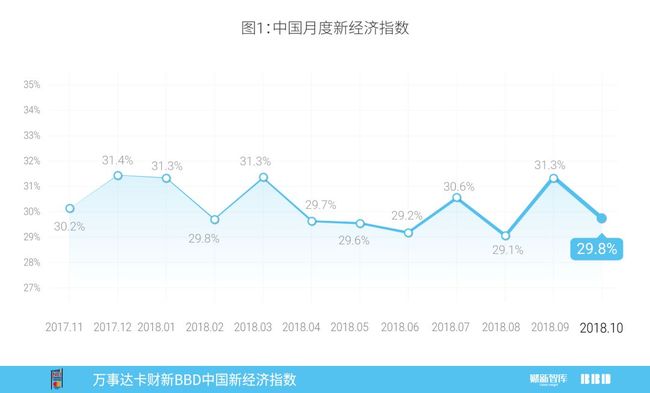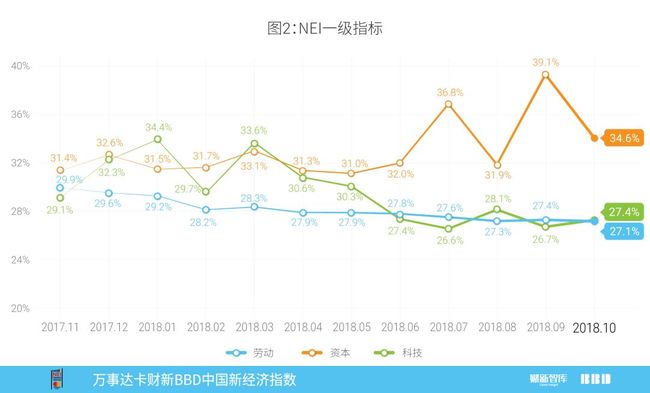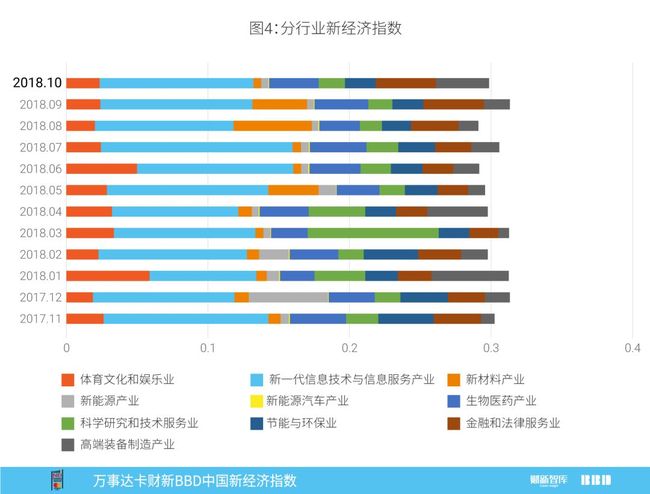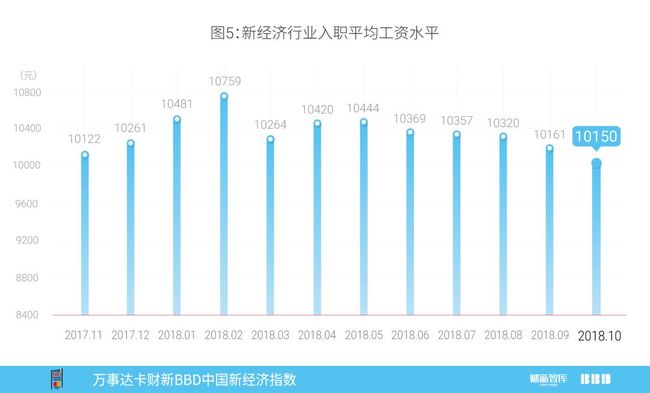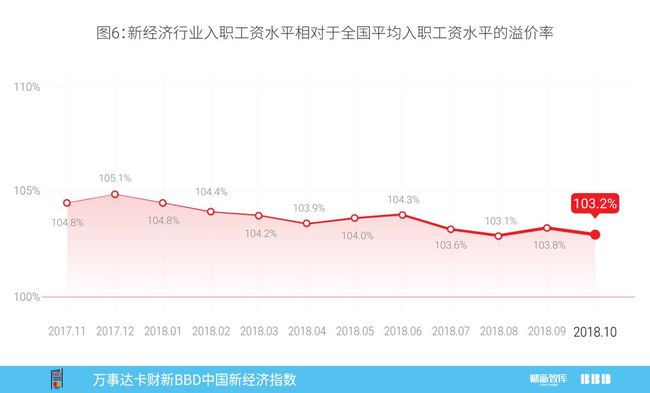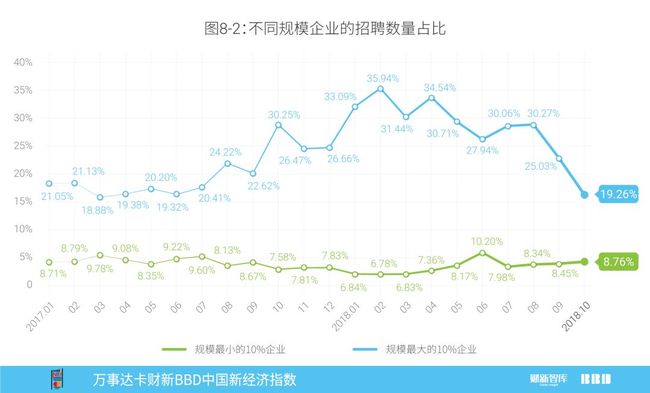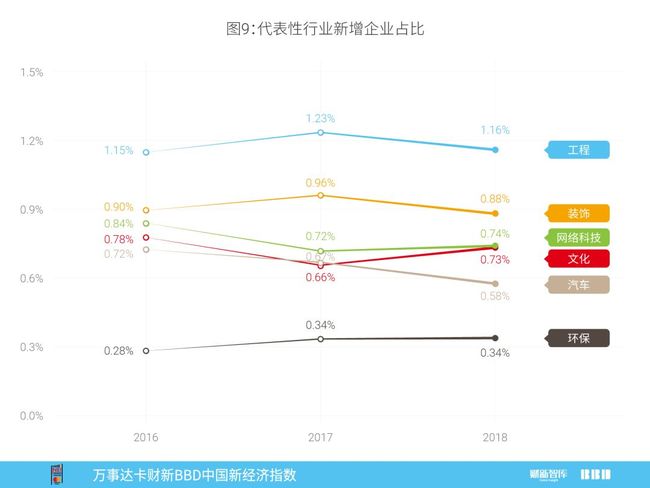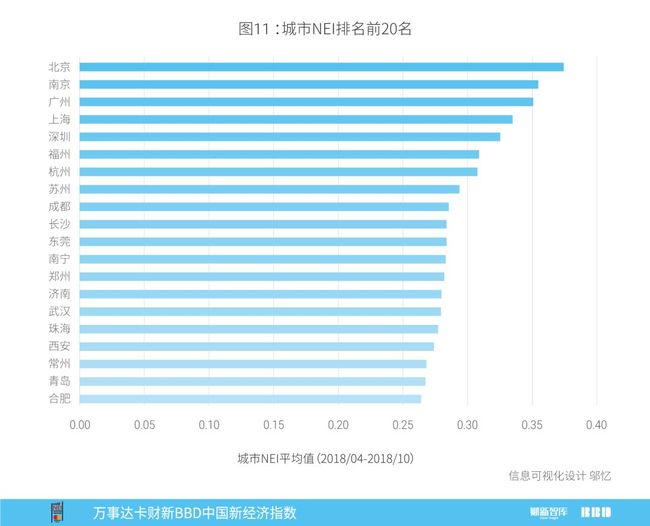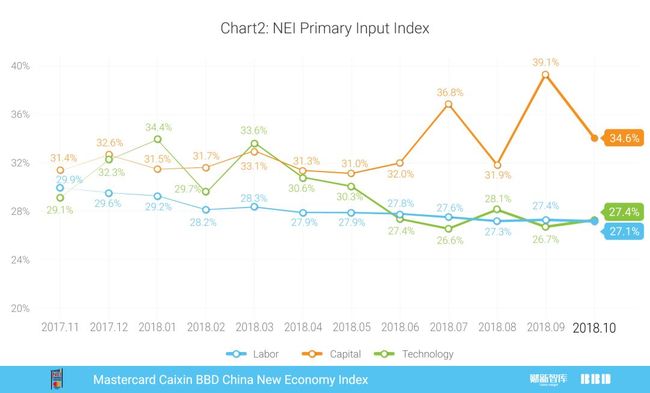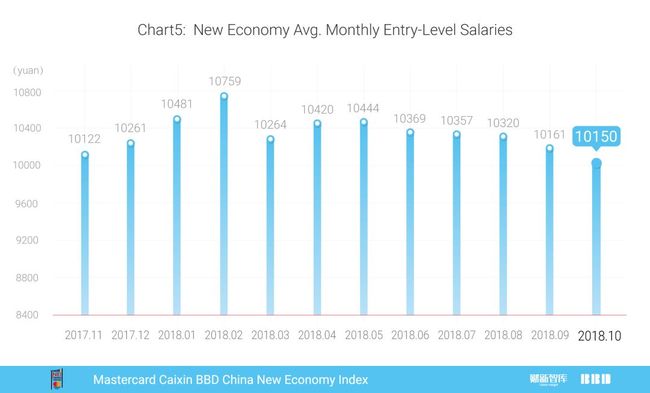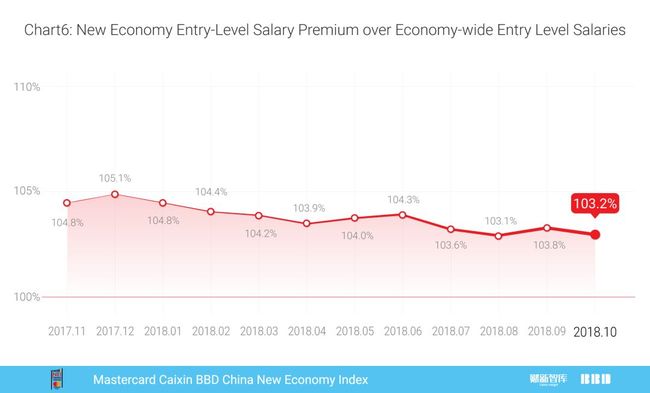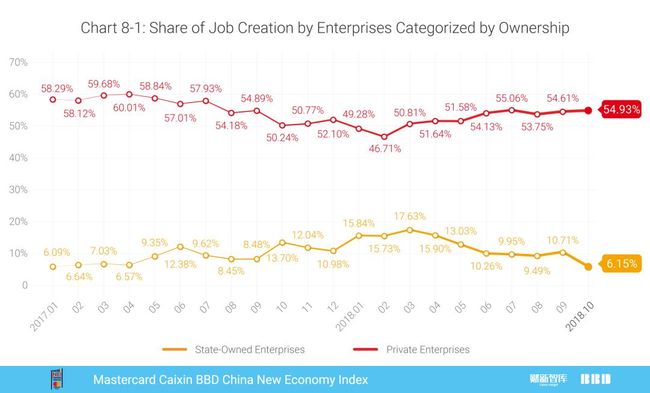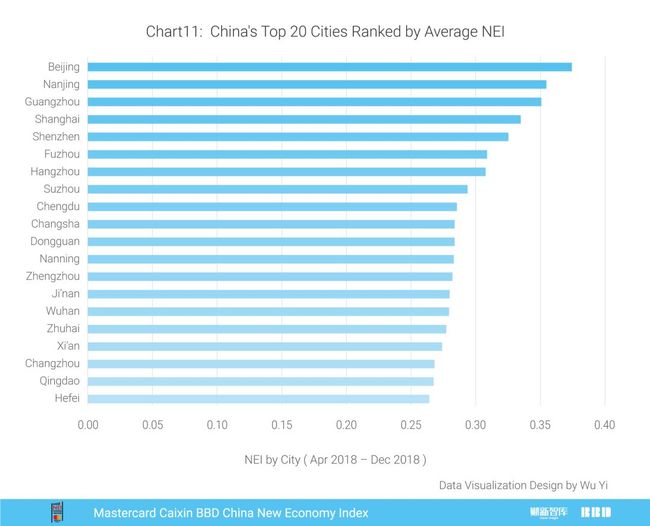2018年10月万事达卡财新BBD中国新经济指数
一、指数概览
2018年10月,万事达卡财新BBD中国新经济指数(NEI)录得29.8,即新经济投入占整个经济投入的比重为29.8%。2017年以来,NEI指数波动较大,按可比口径计算,本月NEI比上月下降1.5个百分点(图1)。本月NEI的下降主要来自资本投入的下降。
NEI新经济据于以下定义:首先,高人力资本投入、高科技投入、轻资产;其次,可持续的较快增长;第三,符合产业发展方向。NEI所含行业详见《万事达卡财新BBD中国新经济指数技术报告》与《万事达卡财新BBD中国新经济指数报告(2017年3月)》。
二、主要分项指标
NEI包括劳动力、资本和科技三项一级指标,它们在NEI中的权重分别是40%、35%和25%。2018年10月NEI的下降主要来自资本投入的下降。科技投入指数从2018年3月开始波动下降,本月指数录得27.4,环比上升0.7。资本投入指数近一年来波动较大,本月指数录得34.6,环比下降4.5。劳动力投入指数变化趋于稳定,本月指数录得27.1,环比下降0.3(图2)。
劳动力、资本和科技投入的变化值分别为-0.1,-1.6,和0.2个百分点,与权重相乘求和后,对2018年10月NEI变化的贡献值为-1.5%(图3)。
分行业看,NEI中占比最大的行业为新一代信息技术与信息服务产业,2018年10月为总指数贡献了10.8个百分点;本月名次上升最快的是高端装备制造产业,从上月的第七名上升到本月的第三名,为总指数贡献了3.7个百分点;本月名次下降最快的是新材料产业,从上月的第三名下降到本月的第八名,为总指数贡献了0.5个百分点(图4)。
三、新经济就业
2018年10月,新经济行业入职平均工资水平为每月10150元,较上月下降11元(图5)。新经济工资主要来自51job、智联招聘、拉钩、赶集网等数个招聘网站的招聘信息,即对劳动力的需求工资。
2018年10月新经济行业招聘人数占全国总招聘人数比例下降0.2%,同时新经济行业招聘总薪酬占全国总薪酬比重下降0.26%,这意味着新经济行业的平均入职工资水平相对于全国平均入职工资水平出现下降。2018年10月新经济入职工资“溢价”为3.2%,相比上月低0.6个百分点(图6)。
四、从劳动力需求数据看经济走势
本月我们关注中国的经济结构。在三季度经济数据中,中国GDP实际增速下降至6.5%,是1992年以来季度同比增速最低的三个季度之一(另外两个季度是1999年第四季度和2009年第一季度),严格遵守了每36到40个季度一个循环的周期。我们认为,经济仍然处于低谷,但接下去不会更糟。
从图7中可以看到,我们已经连续观测了半年的普工和操作工招聘数量仍然在继续下降,但是总体来看,新岗位占比已经出现了回升。这样的新岗位占比回升并没有出现在全国所有行业中,例如IT类、新媒体类、基金类企业的新岗位占比本月仍然在下降,而电子技术类、石油类和酒店类企业的新岗位占比已经出现了显著的回升。这意味着经济的转型经历了看山是山——看山不是山——看山还是山的转型,目前开始从上游能源类、基础技术类开始回升。
五、从劳动力需求数据看各类企业生存状况
2018年3季度的数据显示,国有企业与民营企业的分化有减弱迹象。国家统计局最新发布的数据显示,国有企业利润累计同比大幅下滑,民营企业则相对趋缓。从招聘数据看(图8),国有企业的招聘占比从2017年8月开始上升,在今年的3月达到顶峰,随后开始下降;民营企业招聘占比已显示出良好的回升势头。大企业和小企业的招聘占比也显示出类似的趋势。不同所有制企业之间的资源配置显示出一定的周期性,而目前正处于修复的过程中。
图9列出了2016年10月、2017年10月和2018年10月几类不同行业新增企业占比。可以看到,在过去一年中比例上升较快的工程、装饰企业,今年10月份数据出现了下降,而网络科技、文化传媒等企业出现了回升。当然,也存在着连续两年下降的行业——例如汽车;也出现了连续两年上升的行业——例如环保。
结构上,中国经济已经出现了筑底企稳的迹象。
六、城市新经济排名
2018年10月新经济总量城市排名前20名如图10所示,北京、上海、深圳、广州和南京排名前五。该排序计算每个投入指标在所有城市中的排序百分位,再将百分位加权平均,体现的是近半年城市间新经济总量排名。
图11计算了2018年4月到2018年10月城市NEI平均排名,前五名为北京、南京、广州、上海、深圳。
更多咨询敬请联络:
万事达卡
大中华区公共关系副总裁 吴焕宇
电话:+86-10-8519-9304
财新智库
财新智库高级经济学家 王喆
电话:+86-10-85905019
公关总监 马玲
电话:+86-10-8590-5204
BBD(数联铭品)
BBD(数联铭品)首席经济学家 陈沁
电话:+86-28-65290823
版权声明
万事达卡财新BBD中国新经济指数,是由财新智库(深圳)投资发展有限公司和成都数联铭品科技公司共同研发,与北京大学国家发展研究院合作,经过近一年努力,于2016年3月2日在北京首发的指数产品,此后每月2日上午10:00发布上月数据。
关于万事达卡:
万事达卡(纽交所股票交易代码:MA),www.mastercard.cn,是全球性的支付与科技公司。通过运营全球最快的支付处理网络,万事达卡将超过210个国家和地区的消费者、金融机构、商户、政府和企业连接在一起。万事达卡的产品和解决方案使得每个人在购物、旅行、企业经营、财务管理等日常商业活动都变得更容易、更安全和更高效。敬请关注我们的“万事达卡”官方微信以及在新浪的官方微博@万事达人,以获悉动态并参与互动。也可访问万事达卡新闻中心或万事达卡互动中心获取更多资讯。
关于财新:
财新传媒是提供财经新闻的全媒体集团,依托专业的团队和强大的原创新闻优势,以网站、移动端、期刊、视频、图书、会议等 多层次的业务平台,为中国最具影响力的受众群,提供准确、全面、深入的财经新闻产品。财新智库是财新传媒通过孵化另行建立的高端金融资讯服务平台,旨在通过发展金融数据业务,壮大宏观经济研究队伍,服务于智库业务客户。详细信息,敬请浏览www.caixin.com。
关于BBD:
BBD(数联铭品)是行业领先的大数据解决方案提供商,紧密围绕新经济,通过动态尽调、信用评级、风险定价和经济指数四个步骤,BBD提供从微观到宏观的大数据服务。详细信息,敬请浏览:http://www.bbdservice.com。
October 2018
Mastercard Caixin BBD China New Economy Index
Overview
In October 2018, the Mastercard Caixin BBD New Economy Index (NEI) reading came in at 29.8, indicating that the New Economy accounted for 29.8% of overall economic input activities that month, down 1.5 ppts from September (Chart 1). The declining NEI was due to the decrease of capital input. New economy is defined as following: 1) human capital intensive, technology intensive and capital light, 2) sustainable rapid growth, and 3) in line with the strategic new industries defined by the government. Please refer to our previous reports (March 2016 and March 2017) for the list of NEI sectors.
Primary Inputs
The NEI includes labor, capital and technology inputs that account for 40%, 35% and 25% of the total weights of the index, respectively. The decline in the October NEI reading came from the decrease of capital input (Chart 2). Capital input fluctuated widely in the recent year, dropping to 34.6 this month, with 4.5 MoM decrease. Technology input index went down since March 2018, coming in at 27.4 this month, with 0.7 MoM increase. Labor input index showed a stable trend in the past two months, decreasing slightly to 27.1 this month, with 0.3 MoM decrease.
Taking the weights into account, percentage changes in labor, capital and technology inputs were -0.1, -1.6, and 0.2 ppts, respectively. The net NEI change was -1.5 ppts in total (Chart 3).
As for sectors, the New IT industry formed the largest proportion of the New Economy Index, contributing 10.8 ppts to NEI. Advanced Equipment Manufacturing was the industry with fastest growth in October, contributing 3.7 ppts and ranking the third. Advanced Materials came eighth from third, the biggest drop in ranking, contributing 0.5 ppts in October (Chart 4).
New Economy Employment
In October 2018, the average monthly entry-level salary of the New Economy was RMB 10,150, decreasing from last month’s level of RMB 10,161 (Chart 5). New Economy wage information is compiled from online websites of career platforms and recruitment services including 51job and Zhaopin, as well as other sites that list job openings.
Hiring in the New Economy sectors accounted for 26.7% of the total in October, lower than the previous month’s 26.9%. At the same time, the compensation share of New Economy decreased 0.26%.Accordingly, the average entry salary level of New Economy declined compared to the national level. The entry-level salary premium of the New Economy decreased, from 3.8% in September to 3.2% as compared to economy-wide counterparts (Chart 6).
Economic Trends Based on Employment Data
We focused on China’s economy this month. In 2018Q3, China’s real GDP growth rate fell to 6.5%.It was among the quarters with lowest growth since1992 (1999Q4 and 2009Q1), which indicated a business cycle typically lasting for 36 – 40 quarters. We are in the trough and the macroeconomy won’t be worse in our opinion.
Chart 7 showed the employment of general workers and operators continued to decline and the share of new jobs started to rebound in October. However, not all industries’ new jobs saw a rise. Job creations in Electronic Technology, Petroleum and Hotel sectors were climbing, while the new jobs of IT, New Media and Fund industries were still in decline.We are experiencing an economic transformation cycle and the upstream sectors such as energy and basic research start to recover.
Operation of Different Enterprises Based on Employment Data
In 2018Q3, the divergence between state-owned and private enterprises weakened. According to the National Bureau of Statistics, the growth rate of state-owned enterprises’ profits fell sharply YoY, but their private counterparts were stabilizing marginally. The new employment of state-owned enterprises showed a growth trend since July 2017, but started to drop after reaching the peak in March 2018 (Chart 8). Meanwhile, the job creation by private enterprises began to rebound. So did the new employment of large and small companies.Resource allocation among enterprises in difference ownerships shows a cyclical pattern and it’s currently regressing to the mean.
Chart 9 showed the share of new enterprises in specific areas in October 2016, October 2017, and October 2018. The share of new enterprises in 2017 top-ranked Engineering and Decoration declined in this month, while that in IT and culture went down and up. Besides, sub-sector of Automobile was ranking down in two consecutive years and Environmental Protection sector was experiencing two years of expanding.
China’s Economy is stabilizing in the bottom in terms of structure adjustment.
City Rankings of the New Economy
Based on overall New Economy rankings, the top twenty cities were shown in Chart 10. The top five cities were Beijing, Shanghai, Shenzhen, Guangzhou and Nanjing. Rankings are based on a weighted average of the percentile rank of indicators for the city in the past six months.
Chart 11 showed the average NEI city rankings between April 2018 and October 2018. The top five cities were Beijing, Nanjing, Guangzhou, Shanghai and Shenzhen.
For further information please contact:
Mastercard
Mr. Wu Huanyu, Director, Communications
Tel:+86-10-8519-9304
Email:[email protected]
Caixin Insight Group
Dr. Wang Zhe, Senior Economist
Tel:+86-10-85905019
Emails:[email protected]
Ma Ling, Public Relations
Tel:+86-10-8590-5204
Email:[email protected]
BBD
Dr. Chen Qin, Chief Economist
Tel:+86-28-65290823
Emails:[email protected]
The Mastercard Caixin BBD China New Economy Index is the fruit of a research partnership between Caixin Insight Group and BBD, in collaboration with the National Development School, Peking University. The subject of a year of research, the NEI was first publically released on March 2, 2016 and will be issued the 2nd of every month at 10:00am China Standard Time.
About Caixin
Caixin Media is China's leading media group dedicated to providing financial and business news through periodicals, online content, mobile applications, conferences, books and TV/video programs. Caixin Media aims to blaze a trail that helps traditional media prosper in the new media age through integrated multimedia platforms. Caixin Insight Group is a high-end financial data and analysis platform. For more information, please visitwww.caixin.com.
About Mastercard
Mastercard (NYSE: MA),www.mastercard.com, is a technology company in the global payments industry. We operate the world’s fastest payments processing network, connecting consumers, financial institutions, merchants, governments and businesses in more than 210 countries and territories. Mastercard’s products and solutions make everyday commerce activities – such as shopping, traveling, running a business and managing finances – easier, more secure and more efficient for everyone. Follow us on Twitter @MastercardAP and @MastercardNews, join the discussion on the Beyond the Transaction Blog and subscribe for the latest news on the Engagement Bureau.
About BBD (Business Big Data)
BBD is a leading Big Data and quantitative business analytics firm specializing in the analysis of the high-growth industries emerging in Mainland China. Through dynamic data tracking, credit analysis, risk pricing and economic index construction, BBD provides its clients with a wide range of services at both the macro and micro level. For more information, please visithttp://www.bbdservice.com/.

